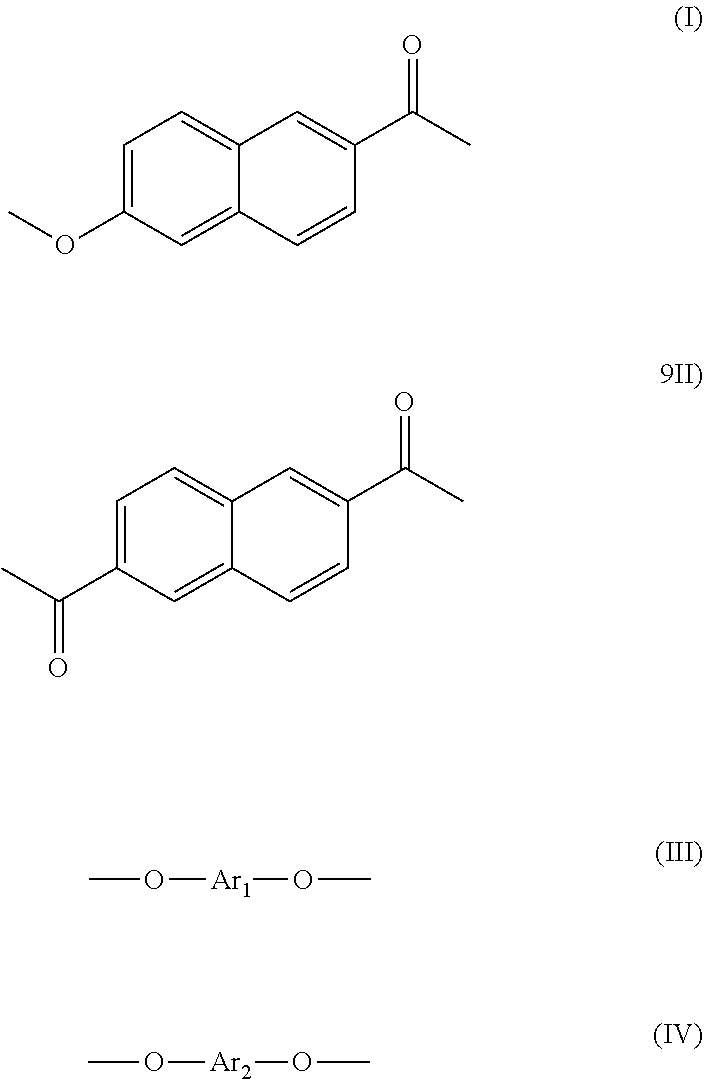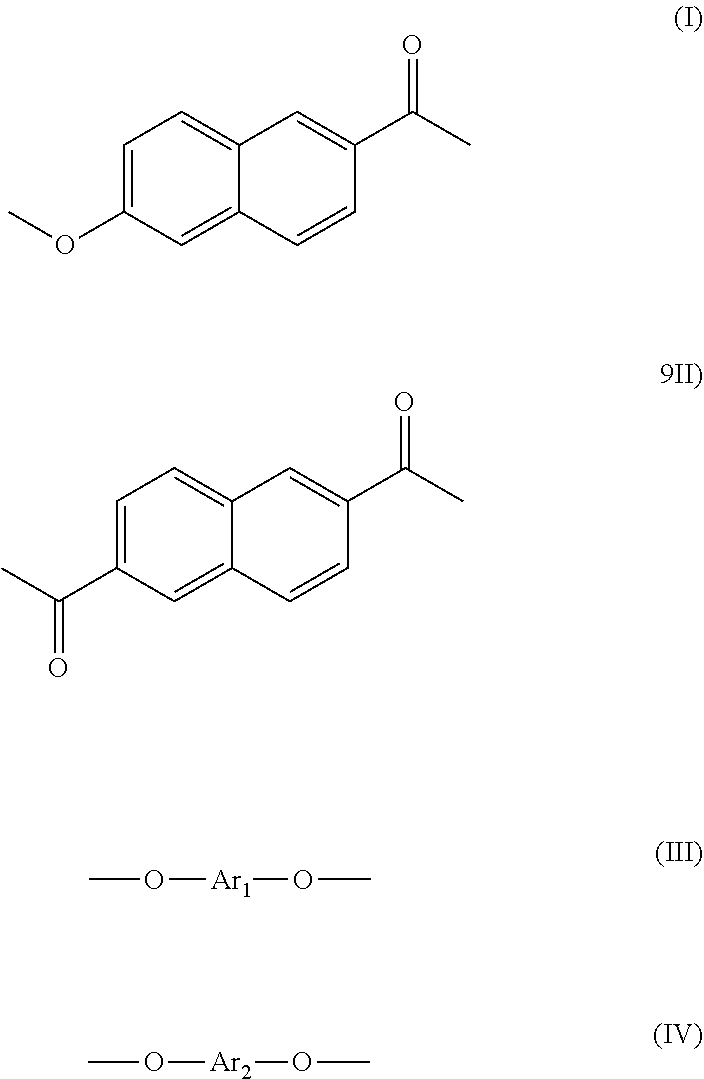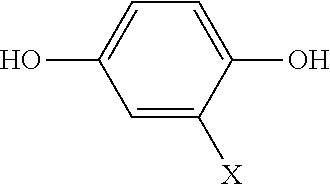Thermoplastic liquid crystal polymer and film of same
a liquid crystal polymer and thermoplastic technology, applied in the field of thermoplastic polymers, can solve the problems of poor moisture resistance, difficult processing, high cost, etc., and achieve the effects of low dielectric dissipation factor, reduced melting point, and low cos
- Summary
- Abstract
- Description
- Claims
- Application Information
AI Technical Summary
Benefits of technology
Problems solved by technology
Method used
Image
Examples
example 1
[0128]Into a 100-mL reactor, were introduced 19.74 g of 6-hydroxy-2-naphthoic acid (60 mol %), 7.56 g of 2,6-naphthalenedicarboxylic acid (20 mol %), 0.96 g of hydroquinone (5 mol %), 4.88 g of 4,4′-dihydroxybiphenyl (15 mol %), 19.64 g of acetic anhydride, and 3.77 mg of potassium acetate as a polymerization catalyst. The mixture was acetylated under a nitrogen atmosphere (at 160° C. for about 2 hours under reflux) and then kept at 280° C. for 0.5 hour, at 320° C. for 1 hour and at 360° C. for 1 hour. Then, decompression treatment (100 Pa) was performed until it is confirmed that forming has stopped (for 30 to 120 minutes), and subsequently the reactor was purged with nitrogen to obtain an aromatic liquid crystal polyester.
[0129]The resultant thermoplastic liquid crystal polymer had a melting point of 294° C. and a solidifying temperature of 228° C., and a temperature difference between the melting point and the solidifying temperature was 66° C.
[0130]The obtained thermoplastic liq...
example 2
[0131]An aromatic liquid crystal polyester was obtained in the same manner as in Example 1, except that the raw materials introduced into the reactor were changed to 20.19 g of 6-hydroxy-2-naphthoic acid (60 mol %), 7.73 g of 2,6-naphthalenedicarboxylic acid (20 mol %), 1.97 g of hydroquinone (10 mol %), 3.33 g of 4,4′-dihydroxybiphenyl (10 mol %), 20.08 g of acetic anhydride, and 3.77 mg of potassium acetate.
[0132]The resultant thermoplastic liquid crystal polymer had a melting point of 291° C. and a solidifying temperature of 237° C., and a temperature difference between the melting point and the solidifying temperature was 54° C.
[0133]The obtained thermoplastic liquid crystal polymer was heat-pressed to obtain a film, and a dielectric constant and a dielectric dissipation factor of the film were measured. The results of the measurement are shown in Table 5.
example 3
[0134]An aromatic liquid crystal polyester was obtained in the same manner as in Example 1, except that the raw materials introduced into the reactor were changed to 20.66 g of 6-hydroxy-2-naphthoic acid (60 mol %), 7.91 g of 2,6-naphthalenedicarboxylic acid (20 mol %), 3.02 g of hydroquinone (15 mol %), 1.70 g of 4,4′-dihydroxybiphenyl (5 mol %), 20.55 g of acetic anhydride, and 3.77 mg of potassium acetate.
[0135]The resultant thermoplastic liquid crystal polymer had a melting point of 309° C. and a solidifying temperature of 252° C., and a temperature difference between the melting point and the solidifying temperature was 57° C.
[0136]The obtained thermoplastic liquid crystal polymer was heat-pressed to obtain a film, and a dielectric constant and a dielectric dissipation factor of the film were measured. The results of the measurement are shown in Table 5.
PUM
| Property | Measurement | Unit |
|---|---|---|
| solidifying temperature | aaaaa | aaaaa |
| dielectric dissipation factor | aaaaa | aaaaa |
| mol % | aaaaa | aaaaa |
Abstract
Description
Claims
Application Information
 Login to View More
Login to View More - R&D
- Intellectual Property
- Life Sciences
- Materials
- Tech Scout
- Unparalleled Data Quality
- Higher Quality Content
- 60% Fewer Hallucinations
Browse by: Latest US Patents, China's latest patents, Technical Efficacy Thesaurus, Application Domain, Technology Topic, Popular Technical Reports.
© 2025 PatSnap. All rights reserved.Legal|Privacy policy|Modern Slavery Act Transparency Statement|Sitemap|About US| Contact US: help@patsnap.com



